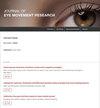在感知视听普通话词调时,口胜于眼
IF 1.3
4区 心理学
Q3 OPHTHALMOLOGY
引用次数: 0
摘要
与辅音和元音相比,声调的视觉线索更隐含,研究也更少。本研究调查了汉语和英语使用者在被要求识别视听普通话词调时的眼动情况。研究人员向汉语和英语使用者展示了普通话单音节(例如:/ă/、/à/、/ĭ/、/ì/)的视听片段,并要求他们识别这些音节是上声调(/ă/、/ ĭ/)还是下声调(/ à/、/ì/)。这些视听音节分别在清晰、嘈杂和无声(无音频信号)的条件下呈现。眼动仪记录了参与者的眼球运动。结果显示,与眼睛相比,被试更多地注视嘴巴。此外,当声音条件变得不利时,说中文和英语的人都会增加注视嘴巴的时间,而不是眼睛。研究结果表明,听者在感知视听词调时主要利用嘴部。中文和英文听者的眼球运动相似,这意味着口腔是提供发音信息的感知线索,而不是社会和语用信息。本文章由计算机程序翻译,如有差异,请以英文原文为准。
Primacy of mouth over eyes to perceive audiovisual Mandarin lexical tones
The visual cues of lexical tones are more implicit and much less investigated than consonants and vowels, and it is still unclear what facial areas contribute to facial tones identification. This study investigated Chinese and English speakers’ eye movements when they were asked to identify audiovisual Mandarin lexical tones. The Chinese and English speakers were presented with an audiovisual clip of Mandarin monosyllables (for instance, /ă/, /à/, /ĭ/, /ì/) and were asked to identify whether the syllables were a dipping tone (/ă/, / ĭ/) or a falling tone (/ à/, /ì/). These audiovisual syllables were presented in clear, noisy and silent (absence of audio signal) conditions. An eye-tracker recorded the participants’ eye movements. Results showed that the participants gazed more at the mouth than the eyes. In addition, when acoustic conditions became adverse, both the Chinese and English speakers increased their gaze duration at the mouth rather than at the eyes. The findings suggested that the mouth is the primary area that listeners utilise in their perception of audiovisual lexical tones. The similar eye movements between the Chinese and English speakers imply that the mouth acts as a perceptual cue that provides articulatory information, as opposed to social and pragmatic information.
求助全文
通过发布文献求助,成功后即可免费获取论文全文。
去求助
来源期刊

Journal of Eye Movement Research
OPHTHALMOLOGY-
CiteScore
2.90
自引率
33.30%
发文量
10
审稿时长
10 weeks
期刊介绍:
The Journal of Eye Movement Research is an open-access, peer-reviewed scientific periodical devoted to all aspects of oculomotor functioning including methodology of eye recording, neurophysiological and cognitive models, attention, reading, as well as applications in neurology, ergonomy, media research and other areas,
 求助内容:
求助内容: 应助结果提醒方式:
应助结果提醒方式:


